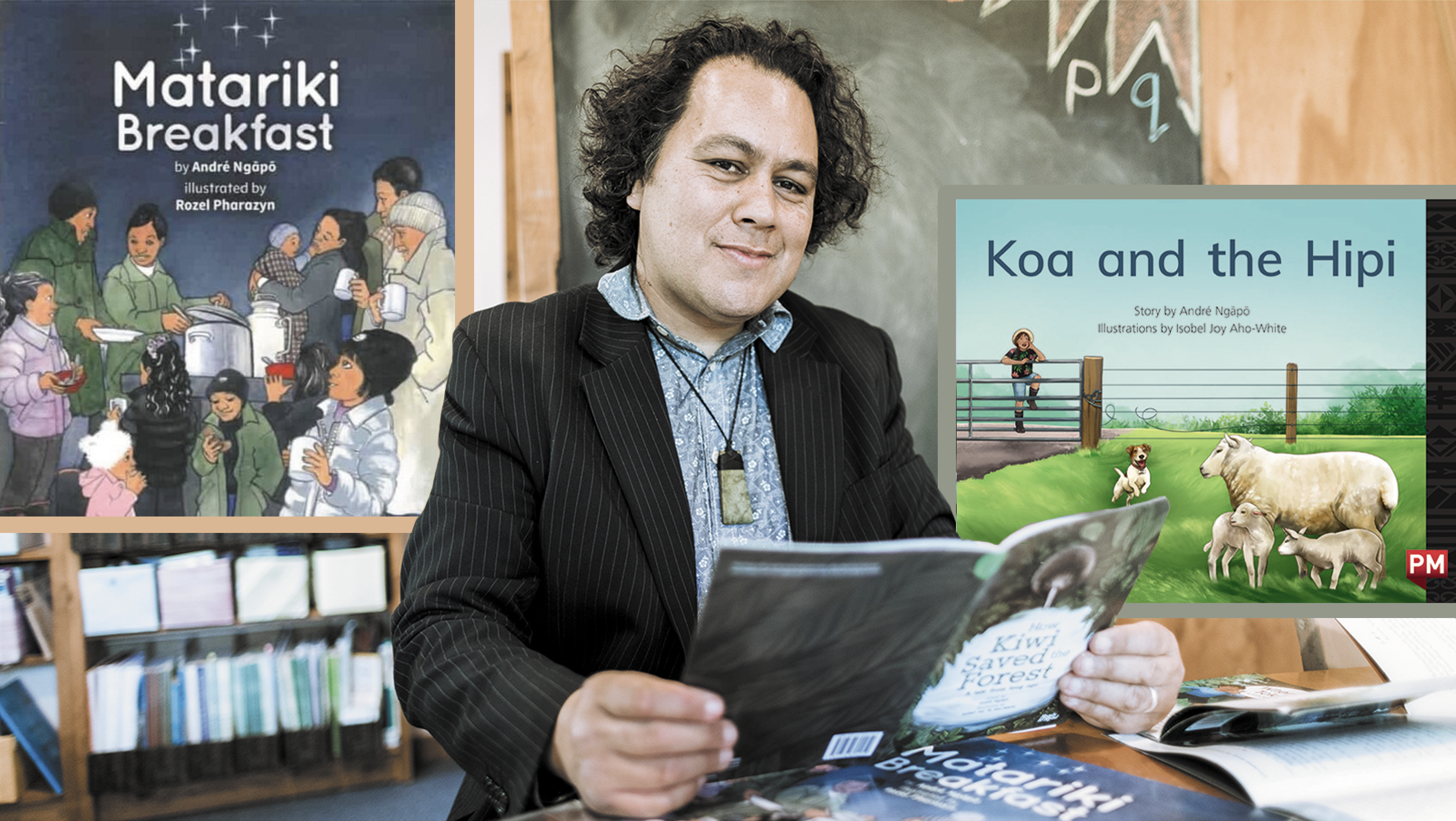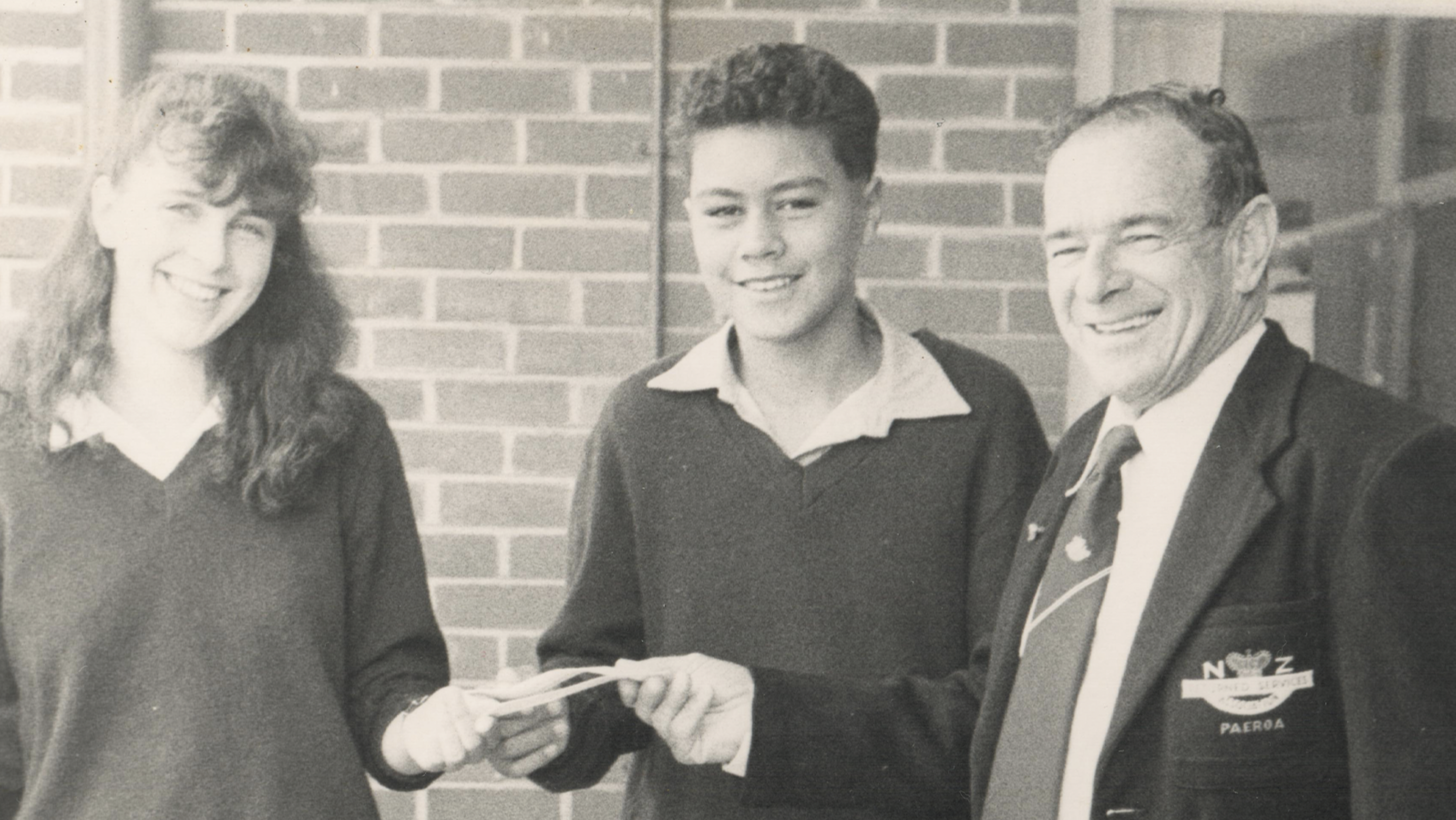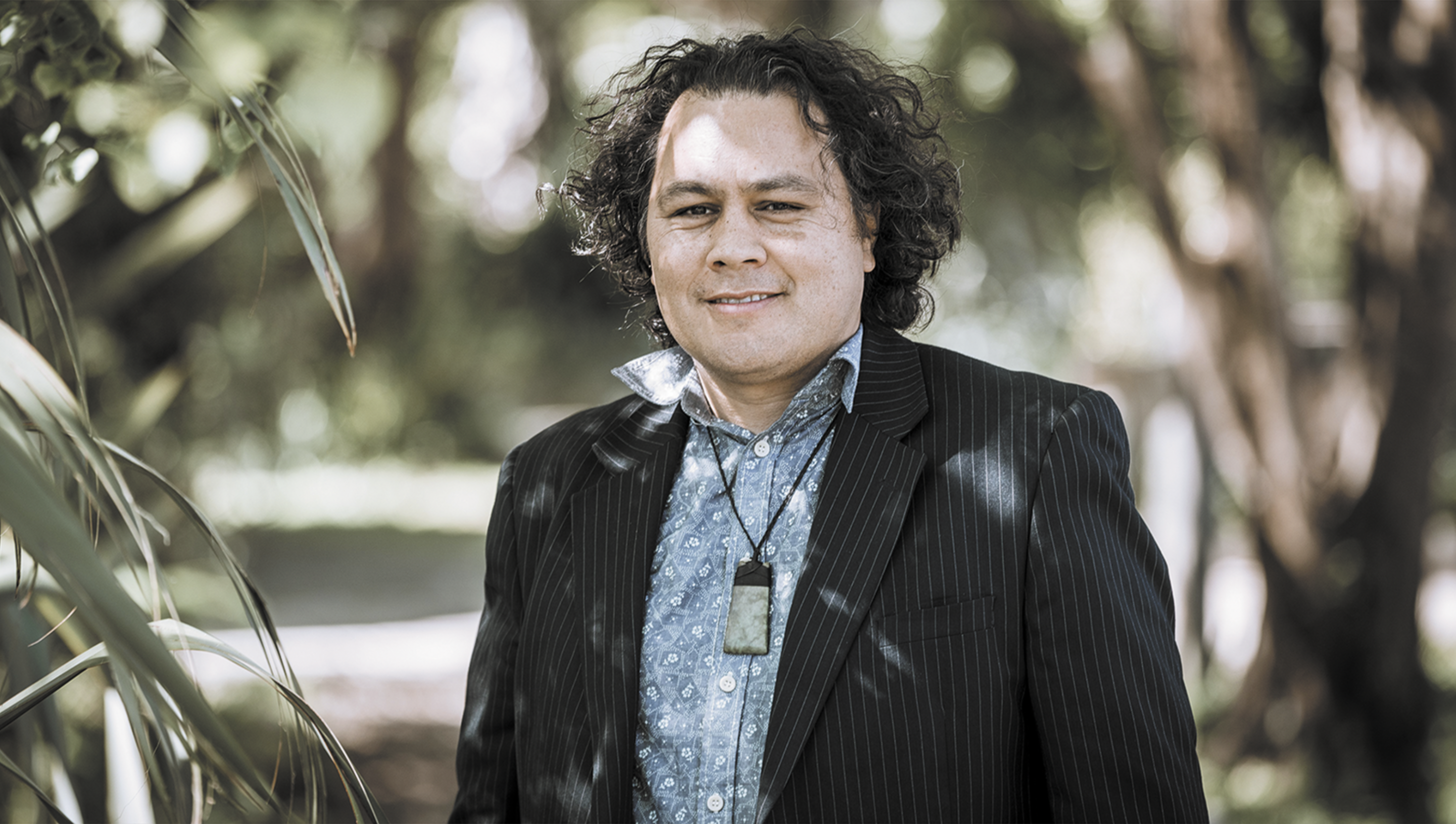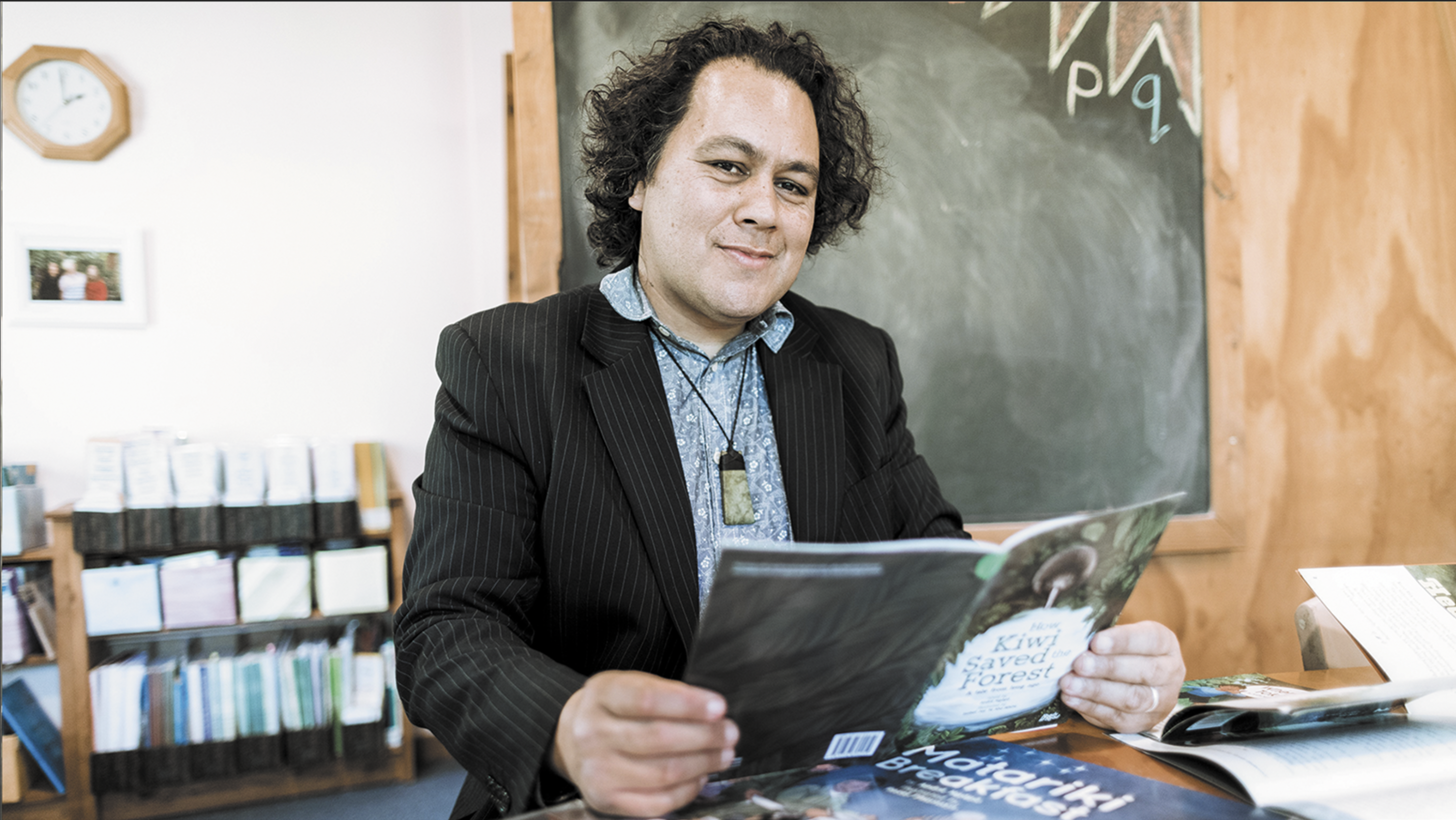The work of some of our most prolific writers for children cannot be found in our libraries or bookshops. For Te Wiki o te Reo Māori, Kura Rutherford celebrates writer André Ngāpō, whose huge body of work has flown under the radar of literary circles and national book awards, but is some of the most influential in the reading lives of tamariki and rangatahi all over the motu.

‘Your name is so familiar,’ the woman says, holding her hand out with a kind of sideways look, ‘where do I know you from?’
‘Are you a teacher?’ the man responds, leaning in for a hongi. ‘I write stories for tamariki.’
‘That’s it!’ she replies, ‘I’m a literacy leader, and I’m in charge of the journal room.’
‘That explains it,’ he laughs. ‘That’s me. World famous in the journal room.’
‘Your name is so familiar,’ the woman says, holding her hand out with a kind of sideways look, ‘where do I know you from?’
This kind of conversation has played out multiple times for André Ngāpō. The 45-year-old teacher, born and raised in Paeroa, and of Ngāti Porou ki Hauraki, Ngāti Tamaterā, Ngāti Awa and Ngāpuhi descent, is used to being ‘kind of recognised’ by people who work in the education sector. Not so much because of his varied teaching roles – he’s worked as a high school teacher, a kaiako with Brainwave Trust Aotearoa supporting rangatahi, parents, professionals and prisoners, and most recently as a primary school teacher on the Kapiti Coast – but because alongside his work as teacher, parent and musician, he has another gift that is on full display in the school journal rooms around Aotearoa.
Ngāpō, who has recently moved with his family to Raumati Beach from Raglan, is a writer. He has written over 40 stories over the last 13 years; stories distinctly set in Aotearoa, full of warmth and humour, and told in a voice so familiar we feel like we know the narrator – even that it might be us.

These stories can’t be found in bookshops or libraries though. They have been published in school journals and other similar educational publications. They are some of the stories that are sent home in book bags, used in classrooms and reading programmes all over the country. Quietly, chipping away behind the scenes, Ngāpō has made some of his living from writing stories that are helping our tamariki learn to read.
While Ngāpō’s significant body of work may have somewhat flown under the radar of literary circles, his first big break is in fact well documented. In 2008, after a nudge from his wife, he literally stood up from his sofa, sat down at his computer and sketched out ideas for a story, ‘Te Pou’, which won the Sunday Star Times Short Story competition. He was the first Māori writer to win this prestigious competition.
Not long after the publication of his winning story he got a call from Learning Media, asking him to have a go at writing for them. They recognised, like the judges of the Sunday Star Times Short Story competition, that Ngāpō’s voice was one that we needed to hear more of. And for Learning Media there was an understanding too that his writing could appeal to tamariki and rangatahi.
…there was an understanding too that his writing could appeal to tamariki and rangatahi.
Since that initial call from Learning Media – where Ngāpō was so giddy from being approached that he literally wrote a story that night which was quickly accepted for publication – he has gone on to write for the Tertiary Education Commission, Lift E Tū, Anton Black (Oranui 1, 2, & 3), Auckland War Memorial Museum, McGraw Hill, DoubleInk, while most recently he has had a whole series of PM Book early readers published by Cengage publishers. This latest series are the first of his stories for children that are available for the public to purchase.
‘I’m especially excited that my Australian whānau can access them,’ he says. ‘So my little nieces and nephews can learn about their Māoritanga.’

Most of his stories are centred in Māori communities, celebrating everyday experiences that are elevated to something special, highlighting themes of cultural identity and values and principles inherent in te ao Māori, often set against a backdrop of colonisation, social deprivation and urban migration. The stories have a feel of someone who’s been there, whether there is in a classroom, in the back blocks of a small Waikato town, or at a tangi – real stuff, but told with warmth and sensitivity and always holding up a positive and optimistic vision of how te ao Māori and whanonga pono can shape outcomes. ‘My stories often centre around resilience, and the power of whānau, the power of our culture and traditions, wrapping around tamariki and rangatahi to bring them strength when times are tough.’
His gift for gently and sensitively shining light on deep issues for Māori is exemplified in one story, Ask Eddie, which is about a young Māori boy struggling with being expected to be expert in protocols when his class are preparing for a visit to a local marae. Through the character of Eddie, Ngāpō helps children to see that not everyone who is Māori has necessarily been to a marae, nor do all Māori understand what happens at a pōwhiri. As the story unfolds, Ngāpō weaves in understandings of kawa and tikanga, ultimately giving Eddie his moment to shine as he presents his beautiful artwork as a koha on behalf of the school during the pōwhiri. As Ngāpō says, ‘It is important to allow tamariki to shine in their own way; Māori achieving success as Māori, whatever their lived experience may be.’
“It is important to allow tamariki to shine in their own way; Māori achieving success as Māori, whatever their lived experience may be.”
The focus for Ngāpō is always about creating something that has an impact, but he often has to work that into a tight brief. The process of writing for educational publications is very specific, and Ngāpō will often get a brief that includes a pre-set theme, a reading level and even sometimes a set number of pages, word per page, requests for illustration specifications, and a group of words that need to be woven into the story. It takes a special kind of skill to create a story out of a set structure, with a lot of puzzling involved, but Ngāpō seems to relish the challenge. ‘The structure is a means to an end. It’s like crafting a song, I’m aiming to touch the heart of the reader, to inspire them, or get them thinking … for me the structure is a vehicle to making a connection with the reader – connecting to their emotions, connecting to the hearts of tamariki.’
It takes a special kind of skill to create a story out of a set structure, with a lot of puzzling involved, but Ngāpō seems to relish the challenge.
Ngāpō has a degree in Human Geography and English literature, as well as diplomas in teaching, te reo Māori and song writing, and since 2011 he has studied child and adolescent brain development with the highly respected Te Mauri Tau/Poutiria Te Aroha, Ruth Beaglehole/Echo Parenting, and Brainwave Trust Aotearoa. All these things have been an advantage for Ngāpō in understanding the complexities of writing for particular reading levels and developmental stages, but he also learnt a lot on the job, through working alongside specialised learning resource editors, and through training.
In 2014, he was part of a group of writers who were given specific training by Lift E Tū Publishers, at a time when the Ministry of Education were increasingly highlighting stories where tamariki Māori saw themselves in the narratives, and more stories that highlighted Māori achieving success as Māori.

Right now, it feels like Ngāpō is only one more nudge away from becoming a household name, and he joins an esteemed group of many famous New Zealand writers who developed their career writing for School Journals and the like. His recent move to Raumati – whilst primarily working fulltime and supporting his family – puts him in a good position to one day make the most of the literary world of Wellington and all the support and opportunities that could give him.
‘Wellington just opens up so many possibilities.’ says Ngāpō. ‘I’ll definitely explore them. I do aim to write fulltime one day. I’ve been strategic, consistently keeping the stories ticking over, while raising my kids and working at a career in education. All the mahi I have done writing short stories for tamariki and rangatahi is ultimately a win-win: I might help them connect to their culture or to see themselves in some way, and the stories help me to keep ticking away at my dream of being a fulltime creative writer.’ He pauses, letting out a cheeky laugh. ‘And,’ he smiles, ‘if the fame comes, it would be great if money follows it!’
“…the stories help me to keep ticking away at my dream of being a fulltime creative writer.”
But focusing on his potential for fame takes away somewhat from what he has already achieved. Ngāpō’s story is one that reminds us to acknowledge and celebrate those people purposefully working away, doing the mahi behind the scenes.
There are metaphors galore that could capture this idea, but the one that stands out is of the ringawera who put in the hard work at a hui to feed all the visitors.
Ngāpō has carried out quiet, background work, but essential work, sharing stories that are wholehearted and authentic, and in doing so, providing literacy-rich cultural and socio-emotional building blocks for our tamariki, turning the everyday encounters of their literacy experience into a feast, prepared with love and creative flair. And like the ringawera who put in the mahi for all of our benefit, André deserves that moment when we all turn toward him and say a huge ‘Ngā mihi ki a koe’.
Ngāpō has carried out quiet, background work, but essential work, sharing stories that are wholehearted and authentic…
In acknowledging Ngāpō’s work, it is also an opportunity to thank all his fellow talented writers, editors, publishers, and the Ministry of Education who give our tamariki an opportunity to see our wonderful history and diversity celebrated through writing that is rich in metaphor and poetic language, and in voices that reflect all of us. These stories are free and available to our tamariki all over the motu, and this too is something worth celebrating.

Kura Rutherford
Kura Rutherford (Te Rārawa, Ngāpuhi) is a school librarian, writer and editor, who lives in Tāmaki Makaurau. She grew up in Hokianga and Grey Lynn, before moving to Hawke’s Bay for 20 years with her husband, Dominic, to bring up their three daughters. She worked for 10 years in public libraries in customer service and community roles before becoming the sole charge school librarian at Taikura Rudolf Steiner School in Hastings. Now having returned to Tāmaki with her family, she works in the same role at Michael Park School in Ellerslie. She has been connected to Steiner education since she was 23 when she and her husband worked for a year at Hōhepa Farm in Hawke’s Bay, and all three daughters have attended Steiner schools. Kura’s writing focus is on health, education and literature, and she has written for The Sapling, Good magazine, EBSCO databases, Magpies magazine, and craft magazine Extracurricular. She has a special interest in supporting organisations in their te reo Māori strategic planning and development aspirations.



